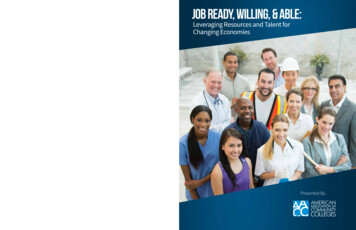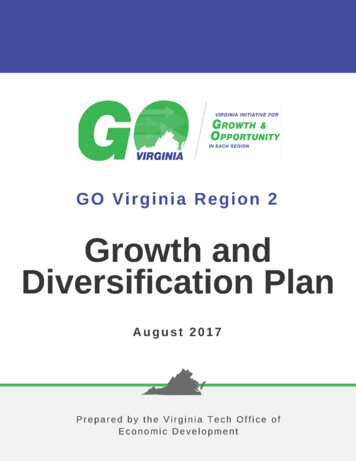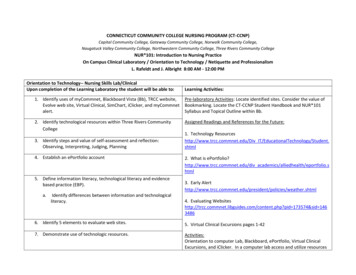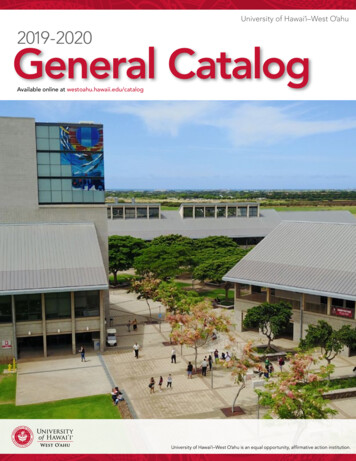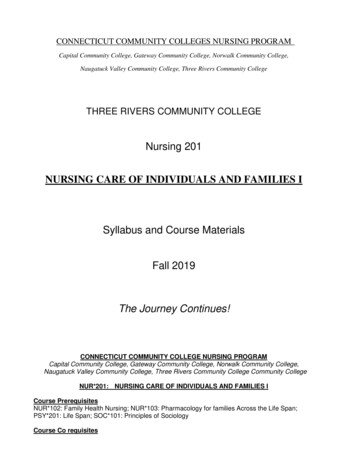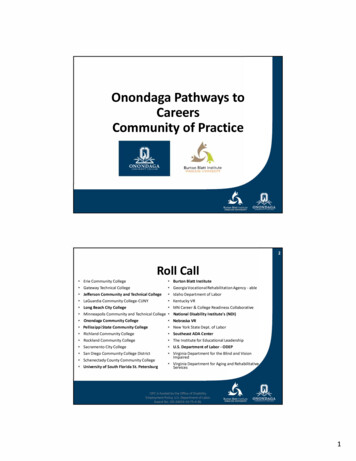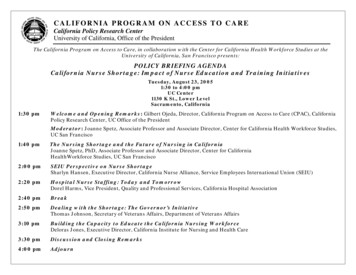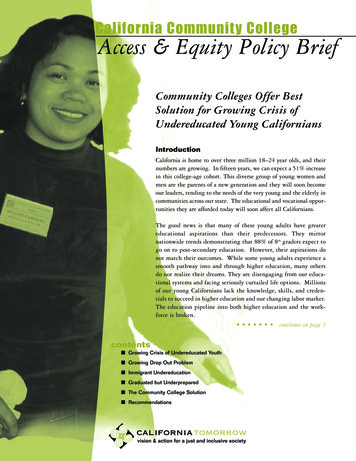
Transcription
California Community CollegeAccess & Equity Policy BriefCommunity Colleges Offer BestSolution for Growing Crisis ofUndereducated Young CaliforniansIntroductionCalifornia is home to over three million 18–24 year olds, and theirnumbers are growing. In fifteen years, we can expect a 51% increasein this college-age cohort. This diverse group of young women andmen are the parents of a new generation and they will soon becomeour leaders, tending to the needs of the very young and the elderly incommunities across our state. The educational and vocational opportunities they are afforded today will soon affect all Californians.The good news is that many of these young adults have greatereducational aspirations than their predecessors. They mirrornationwide trends demonstrating that 88% of 8th graders expect togo on to post-secondary education. However, their aspirations donot match their outcomes. While some young adults experience asmooth pathway into and through higher education, many othersdo not realize their dreams. They are disengaging from our educational systems and facing seriously curtailed life options. Millionsof our young Californians lack the knowledge, skills, and credentials to succeed in higher education and our changing labor market.The education pipeline into both higher education and the workforce is broken. continues on page 3contents Growing Crisis of Undereducated Youth Growing Drop Out Problem Immigrant Undereducation Graduated but Underprepared The Community College Solution Recommendations
Statewide Advisory CommitteeIrma Archuleta, EOPS DirectorSanta Ana CollegeBrian Cheu, Executive DirectorChinese for Affirmative ActionAlona Clifton, TrusteePeralta Community College DistrictLinda Collins, DirectorCareer Ladders ProjectDr. Phillip Day, ChancellorCity College of San FranciscoDr. Denise G. Fairchild, PresidentAbout California Tomorrow’s Community College Access &Equity InitiativeFounded in 1984, California Tomorrow is a non profit organization thathas built a strong body of research and experience supporting individual,institutional, and community change work around matters of diversity and equity in: public schools, community building organizations,family serving institutions, early childhood programs, philanthropy, andthe after school/youth development arena.CD Tech Center at Los Angeles Trade Tech CollegeToni Forsyth, Executive DirectorDiversity in Teaching and Learning and FacultyDe Anza CollegeWarren Furutani, TrusteeLos Angeles Community College DistrictRobert Gabriner, DeanResearch, Planning, & GrantsCity College of San FranciscoTony Gamble, Transfer Center Director, Past SenatePresidentWest Los Angeles CollegeVeronika Geronimo, Policy AdvocateAsian Pacific American Legal CenterCalifornia Tomorrow works with a diverse cross-section of community,civic, campus, system, and policy leaders to increase access and equity in California community colleges. We are focused on three areas ofwork: Public Education and Advocacy efforts in which we providebriefings, presentations, and workshops to share our research and policy recommendations with a wide range of state policymakers, community and civic leaders, and community college leaders; a CampusChange Network to provide support to teams of campus leaders(presidents, faculty, staff, students) who are working to enact accessand equity-related reforms; and Alliance Building to facilitate andstrengthen connections among community college access and equityadvocates, the leaders of educational equity and civil rights organizations, and workforce development and business leaders.Liz Guillen, Policy AdvocatePublic AdvocatesKaren Halliday, PresidentLas Positas Community CollegeStephen J. Handel, National Director of CommunityCollege InitiativesThe College BoardAlfred Herrera, DirectorCenter for Community College Partnerships, UCLASue Homer, Political Science FacultyIn 2003, California Tomorrow released California’s Gold: Claiming thePromise of Diversity in Our Community Colleges, a comprehensivestudy that examines how diverse students are faring in the state’scommunity colleges. In addition to identifying promising instructionalpractices and support strategies for increasing access and successamong our most vulnerable students, the study also identifies thechallenges facing campus and system leaders who are working toensure the state can keep its promise to provide accessible andequitable higher education for all Californians.City College of San FranciscoAllison G. Jones, Assistant Vice ChancellorOffice of the ChancellorThe California State UniversityDr. Martha Kanter, ChancellorFoothill-De Anza Community College DistrictHelene Lecar, ChairCalifornia League of Women Voters' CommunityCollege System Issue for EmphasisAcknowledgements:We are grateful to the members of our Statewide Advisory Committeefor their invaluable counsel in framing issues and priorities for thisAccess & Equity Initiative. We want to acknowledge the support of LizGuillen, Public Advocates; Dr. Julie Mendoza, UC College Prep Online(formerly with UC ACCORD); Susan Sandler, Justice Matters; andRogéair Purnell, Irvine Foundation, for offering critical feedback andadvice in the writing of this brief.Jonathan Lightman, Executive DirectorFaculty Association of CA Community CollegesNancy Malone, CCC Academic SenateEnglish Instructor, Diablo Valley CollegePhillip D. Maynard, Academic Senate President &Communications FacultyMt. San Antonio CollegeA special thank you goes out to Elizabeth Dominguez, CAPCounselor/Coordinator, for sharing the successes of her program;Patrick Perry from the California Community College Chancellor'sOffice for his invaluable data; and Skyline College for the use of theirstock photography.This Access & Equity Initiative is funded by The William and FloraHewlett Foundation and the Ford Foundation.next page
Statewide Advisory Committee continued from page 1Wanda Morris, At Large RepresentativeAccording to the National Center for Higher Education ManagementSystems (2000) in California, for every 100 students who enter 9th grade,only 70 graduate from high school in four years. And of those 70 highschool graduates, only 37 enter college, only 25 are still enrolled in college after sophomore year, and only 19 earn a degree within six years ofentering college. Disproportionately, these patterns impact low-incomepeople, communities of color, and immigrants. According to a recentInstitute for Higher Education Leadership & Policy Report, amongCalifornia’s 18-24 year olds, 60% of Asian & Pacific Islanders and 43% ofWhites are enrolled in college while only 32% of African American and22% of Latino 18-24 year olds are enrolled in college.1 Because thoseyoung people who are least well-served by our education system are alsothe fastest growing segment of this age population, without immediateand sustained leadership this crisis can only get worse.Derecka Mehrens, Lead OrganizerStatewide Academic Senate & Nursing FacultyCompton CollegeCalifornia ACORNMike MowerySocial Venture PartnersKeith Muraki, CounselorSacramento City CollegeJulie Olsen Edwards, FacultyEarly Childhood EducationCabrillo CollegeRosa Perez, ChancellorSan Jose Evergreen Community College DistrictBetsy Regalado, Dean of StudentsLos Angeles City CollegeAlberto Retana, Organizing DirectorCommunity Coalition (Los Angeles)Solomon Rivera, Executive DirectorFortunately, there is one institution uniquely positioned to address theacademic preparation of this group and to propel them along pathwaysto college degrees and vocational certifications — the CaliforniaCommunity College System (CCC). California’s investment in creatingthe largest and most comprehensive community college system in thenation means there is a viable alternative. Community colleges providean affordable, open-access gateway to higher education. They are a wayback into school for discouraged learners and drop-outs, a pathway intohigher education for the underprepared, and a means of vocationalpreparation for all. But as the demand for enrollment increases dramatically to accommodate a huge influx of new students and as budget woescontinue to force a variety of short-term focused cuts in our educational systems, the survival and effectiveness of community colleges havebecome seriously threatened.Fixing California’s educational pipeline so that it can meet the needs ofundereducated youth and help us produce an educated and skilled citizenry and workforce will require that we simultaneously strengthenboth our K-12 public education system and the CCC. Yet our fundingmechanisms and political process pit the two systems against eachother. The solution lies in equity-focused reforms of both systems, withspecific attention to the relationship and transitions between these twovitally important educational institutions.1 Shulock, Nancy & Colleen Moore. Variations on a Theme: Higher Education Performancein California by Region and Race. Institute for Higher Education Leadership & Policy,Sacramento, CA, June 2005.For more information on ways to get involved please visit our website: www.californiatomorrow.org, or contact: Rubén Lizardo at rubenl@californiatomorrow.org or IreriValenzuela-Vergara at ireriv@californiatomorrow.org.community college access and equity policy briefCalifornians for JusticeSusan Sandler, PresidentJustice Matters InstituteLuiz Sanchez, Executive DirectorInner City StruggleDiana Spatz, Executive DirectorLIFETIME, Oakland, CA.Regina Stanback-Stroud, VP of InstructionSkyline CollegeAbdi Soltani, Executive DirectorCampaign for College OpportunityThomas Tseng, PrincipalNew American DimensionsJaye Van Kirk, Professor of Psychology, NationalPresident Psi BetaSan Diego Mesa CollegeDr. Blaze Woodlief, DirectorESL DepartmentMarin Community CollegeCalifornians TogetherOrganizational affiliations are for identification purposes only.Project Team:Rubén Lizardo, DirectorJhumpa BhattacharyaJackie HowellLaurie OlsenIreri Valenzuela-VergaraEditors: Jo Ellen Green Kaiser, Laura SaponaraProofreader: Nirmala NatarajDesigner: Guillermo Prado, 8 point 2 design California Tomorrow 2005
"Many academic, business, government, and community leaders are deeply concerned about the drop-out crisisin California’s public schools, particularly in inner city racially segregated districts. In Los Angeles the crisishas reached epic proportions, as we are witnessing alarming rates of disengagement from education as early asmiddle school. Today, there is an urgent need for a more accurate portrait of the dropout problem in order toidentify promising points of intervention. Both the symptom and cause must be well understood and treated.Effective strategies to re-engage and support our youth are desperately needed, and community colleges willneed to be a central element of our efforts to repair the failing educational pipeline."— Dr. Julie Mendoza, UC ACCORDRecently released policy reports and studies haveencouraged the development of strategies for regionalcollaboration between the K-12 system, community colleges, and four-year colleges and universities. Thismakes sense. As such regional planning efforts takeplace, it is essential that space is made for the participation of educational equity advocates, particularly thosewith youth and adult constituencies that are most directly impacted by the issues presented here. Equally essential is the commitment to develop recommendations andplans that are based on data and analysis regarding thevarious challenges and barriers these Californians face.Policies must be based on those strategies and resourcesthat have proven to increase success for the students inmost urgent need.4Our ability to “college-educate” this diverse group ofCalifornians will determine both their individual economic prospects and our state’s overall economicstrength. This “Access and Equity Policy Brief” examines the challenges we face in halting and reversing thecrisis of undereducation among young Californians.The brief provides data and analysis that community,civic, and policy leaders can use to better understand thecracks in our current educational pipeline and thepromising solutions that the community colleges offer.Finally, in this brief we offer recommendations toaddress the obstacles and barriers community collegeleaders are facing as they work to strengthen and expandaccess and success for our most vulnerable students.community college access and equity policy brief
Part I: A Growing Crisis of Undereducated YouthToday one million 18–24 year old Californians (about 30%) do not have a highschool diploma. A very close association exists between education and employment.High school drop-outs are four times more likely than college graduates to beunemployed. In 2000, the Center for Labor Market Studies at NortheasternUniversity found that 638,000 of these 16–24 year olds were out of school and alsojobless. Even when employed, high school drop-outs earn only 70% of what graduates earn. The U.S. Census estimates that a high school drop-out will earn 270,000 less than a high school graduate, over her/his working life.2 As more andmore jobs require some kind of post secondary training, the earning gap betweenschool drop-outs and young people with some form of college credential will groweven larger. High School Graduation RatesWhites: 78 %80African Americans: 57%70Latinos: 60%Native Americans: 53%605040English LanguageLearners: 27%3020Growing Drop-out ProblemCalifornia ranks 45th among the 50 states in terms of graduation rates. As severalrecent studies have demonstrated, our state’s pronounced graduation gap is characterized by race, class, and immigrant status. According to the Urban Institute, while78% of White students graduate from our high schools, only 57% of AfricanAmericans, 60% of Latinos, and 52% of Native American students graduate.Meanwhile, at 54% and 50% respectively, the graduation rates for young men in theLatino and African American communities are even more alarming. According to arecent study by the Harvard Civil Rights Project, less than two-thirds of all studentsgraduated from high schools in central city districts and in communities that sufferfrom high levels of racial and socio-economic segregation.3 Of the English LanguageLearners who even reach high school, an estimated 27% make it to graduation.100 Male High School Drop Out Rates60%48%s: 53ans:ricanicer%em6mos: 4 Native Aan ALatinAfric5040302 Orfield, G., Losen, D., Wald, J., & Swanson, C. Losing Our Future: How Minority Youth are BeingLet Behind by the Graduation Rate Crisis. The Civil Rights Project at Harvard University,Cambridge, MA, March 2004. Contributors: Urban Institute, Advocates for Children of New York,and The Civil Society Institute.3 Harvard Civil Rights Project. Confronting the Graduation Rate Crisis in California. The Civil RightsProject at Harvard University, Cambridge, MA, March 2005.205100Urban School DistrictsGraduation rates in individual districts and schools – particularly those with high concentrations of students ofcolor — remain at crisis-level proportions. According to Professor Robert Balfanz of Johns Hopkins University,African American and Latino students are three times more likely than White students to attend a high school wheregraduation is not the norm and where less than 60% of 9th graders obtain diplomas four years later.According to Dr. Julie Mendoza of UC ACCORD, only 43% of all 9th graders who entered the Los Angeles UnifiedSchool District's high schools in Fall 2000 were enrolled three years later. The majority of these 26, 000 students areAfrican American and Latino. Their exodus from school is especially pronounced between grades 9 and 10.This pattern is not unique to Los Angeles. According to Ed Trust-West, African American and Latinos in theOakland Unified School District have 46% and 37% graduation rates respectively.community college access and equity policy brief
Immigrant UndereducationNot all young people without high school diplomas are drop-outs. We are an immigrant state andimmigrants arrive in the United States at all ages. Those who come to this country as adolescentssometimes never enroll in U.S. schools. A great number of young immigrants work to supporttheir family in the precarious economic situations so many face. Some have completed the minimum years of schooling required in their country of birth (e.g., 8 years in Mexico) but face largegaps in academic preparation for high school in the United States that cannot be overcome withinthe structures of our high school curriculum. Others enter the United States already older than theage of compulsory school attendance here, or have been denied or discouraged from enrollment inhigh school because of their age. While there is no exact count of this population, almost one thirdof this age group (18–24 year olds) who spoke Spanish at home had never enrolled in a U.S. school(compared to 8% of Asian language speakers).For those who do enroll in secondary schools, high school policies and the traditional structure ofsecondary education make it particularly difficult for immigrant adolescents to attain a high schooldiploma. The lack of bilingual courses that would enable students to pursue high level academiccourses before they are proficient in English means that those without sufficient English skills cannot access or succeed in high school academic classes. Gate-keeping tests offered only in Englishmake it difficult for immigrants to demonstrate what they know and to earn a high school diploma. The result is academic failure, and a larger number choosing to abandon school. This cyclefuels the disproportionately high drop-out rates and tremendous rates of undereducation amongyoung immigrant women and men.“We're concerned about the high drop-out rate in California and the large number of young people who just disappearfrom schools. And we know that the High School Exit Exam will make the drop-out rate worse, not better. We needto fix the public schools in this state so they engage and really educate our students, and be sure that the communitycollege system remains an open door back into education for those who were failed in the K-12 system.”— Solomon Rivera, Executive Director, Californians For Justice6Graduated but UnderpreparedThe crisis of undereducation among young adults in California is only partly due to drop-outs andthose who never enrolled. Every year, a majority of young people who graduate from high school havecompleted the general education requirements without getting the preparation they need to succeedin college. In fact, only one in five graduates has met the A-G course requirements students must passin order to be eligible to qualify for admission to a four year public university in California.Low-income students and students of color overwhelmingly attend secondary schools with significantly fewer resources than wealthier, predominantly White suburban schools. Schools with highconcentrations of students of color and language minority students disproportionately have insufficientnumbers of books for students, fewer qualified teachers, and problems with inadequate ventilation,leaks in ceilings, malfunctioning or non-existent air-conditioning, and broken toilets. They havefewer laboratories for studying college preparatory science and fewer counselors to provide informationthat first-time college-goers might need to plan a course of study for college enrollment (the counselor ratiocommunity college access and equity policy brief
is now 1:1900 in many urban districts). All of these inequities, compounded by pervasive low expectations and lack of attention to the specific needs of groups like English Language Learners, add up to ahigh school diploma that, for many students, doesn’t actually prepare them for higher education.GEDs Are Not EnoughThough some of these young people who drop out or never enroll in high school eventually willget a GED, we know that fewer than 18,000 GEDs were awarded last year. The vast majority ofour young men and women remain without diplomas. The 3.1% ratio of GED awards to those withless than a high school education (18–24) places California 49th out of 50 states on this measure.Even the GED does not provide a sufficient solution. Recent research by Russell Rumberger of theUniversity of California, Santa Barbara, suggests that a high school equivalency diploma does not yieldthe same benefits as a high school diploma. A GED certificate gives workers significantly more earning power if it is combined with some post-secondary training and education. However, a GED aloneproduces only small improvements in earnings. For example, drop-outs — even those who later geta GED — tend to experience long periods of unemployment.4 In 2000, a time of very low unemployment in the country, only slightly more than half of drop-outs were employed at any given time. Percent of 16-24 Year OldsEmployed by Level ofEducationDropouts: 58%GED: 64%High School Graduates, NoCollege: 79%AA Degree or Higher: 93%0204060801007 Percent of 16-24 Year OldsExperiencing Long-TermUnemployment by Level ofEducationDropouts: 27%High School Graduation,No College: 11%AA Degree or Higher: 3%051015202530Source both : Wald, Michael & Martinez, Tia. Connected by 25: Improving the Life Chances of the Country’s Most Vulnerable 14-24 YearOlds. Stanford University, Palo Alto, CA. November 2003.4 Wald, Michael and & Martinez, Tia. Connected by 25: Improving the Life Chances of the Country’s Most Vulnerable 14-24 Year Olds.Stanford University, Palo Alto, CA. November 2003.community college access and equity policy brief
High School Exit Exam Will Add to Crisis of Undereducated YouthAs of 2006, all students will be required to pass the California High School Exit Exam (CAHSEE)in order to earn a high school diploma, whether or not they have attended schools that provide theopportunities and supports to learn the material in the exam. Aligned with content standards, thehurdle it poses to graduation is not high — an 8th grade level in math and a 10th grade level inEnglish-language arts. That minimum achievement standard is well below the academic preparation our young men and women will need to succeed in 21st century California. The CAHSEE flooris nowhere close to the academic mastery students need to successfully complete the A-G courserequirements. This level of preparation is also far below the basic knowledge and skill level youthwill need to successfully develop the competencies business leaders expect from entry-levelemployees. That is, even students who succeed in passing the CAHSEE will not necessarily be prepared for the post-secondary education or careers they desire.Right now, almost one million 18–24 year old Californians lack high school diplomas. All indications show that holding the Class of 2006 to the CAHSEE requirement will increase this problem.Based on the results of early testing in 2004 and 2005, the California Department of Educationindicates that 12% of the State’s Class of 2006 will fail either the English-language arts ormathematics section of the exam. Researchers at UCLA/IDEA predict that the failure rates will becloser to 20% for English-language arts and Mathematics.5 Whatever the percentage actually endsup being, an independent evaluation conducted for the California Department of Education hasconcluded that close to 100,000 seniors will not receive diplomas this year — because they havenot passed CAHSEE.Meanwhile, the numbers from the 2004 and 2005 tests also confirm that the failure rate for CAHSEE will disproportionately impact students of color, immigrants, and special education students(see chart). The numbers for Special Education students who were unable to pass either theEnglish-language arts or mathematics sections of the exam were so high — nearly 50% — that theState has agreed to postpone implementation of CAHSEE for Special Education Students.8CAHSEE Failure Rates Based on 2004 and 2005 Tests6Sections of ExamAfrican AmericansLatinoELL StudentsSpecial Education StudentsEnglish Language Arts18 %29 %40 %46 %Mathematics24%30 %39 %49 %5 Rogers, John, et al. More Questions than Answers: CAHSEE Results, Opportunity to Learn and the Class of 2006. UCLA/IDEA,Los Angeles, CA, April 2005.6 ibidcommunity college access and equity policy brief
Considering that these numbers measure a failure to achieve a minimum standard that is belowwhat students need to succeed in society, the picture early CAHSEE results paints of Californiastudents’ academic preparation should be cause for deep concern.The High Price of an Undereducated GenerationIncome and education are more closely linked today than at any other time in our history. Whetheryoung people have dropped out or disappeared from high schools, never enrolled at all, or receiveda diploma without having received the education they need, undereducation has a high price.Economic success and full participation in our democracy, as well as access to family-supported jobsand/or vocational training, require education beyond high school.“Our education system was designed to meet the needs of the 20th century industrial economy, a dramaticallydifferent world than the one we inhabit today. It is hard to see how we will meet the needs of the 21st centuryknowledge economy without improving the effectiveness of our pipeline from high school through college.”— Job for the FutureThis is a crisis of equal opportunity and future options for the millions of young people who areundereducated in our state. But it is also a crisis for the future of our state overall, particularly inlight of the rapidly changing demographic make-up of our workforce. According to research conducted by the California Budget Project, in just 15 short years 70% of California’s prime age workforce (25–54) will be non-White. Additional data and challenges associated with our under-prepared adult workforce are discussed in a forthcoming California Tomorrow policy brief. California’slong-term economic well-being is dependent on the leadership steps taken today to radicallyimprove educational outcomes for young Californians.9community college access and equity policy brief
Part II: Community College SolutionThe CCC is the only system of higher education that has the mission, the enrollment policies andthe characteristics to meet the needs of the undereducated young adult population in our state. The109 community colleges in our state offer this diverse and underprepared group the kind of support and flexibility they require to move forward with their education. Community colleges canoffer students multiple pathways to success, provide students with comprehensive support, andhave begun innovative partnerships with high schools and middle schools. In this next section, wedescribe these three strategic factors — multiple pathways, comprehensive support, and innovativepartnerships — that make community colleges so important to the state’s efforts to turn aroundeducational outcomes for young women and men.“Our Statewide advocacy for educational equity and our recent historic settlement in Williams v. California toensure the most basic resources for the most underserved students underscores the important role communitycolleges must play in California’s educational pipeline.As we work to ensure resources and teaching in K-12schools are organized to provide all young people with a real opportunity to succeed academically, we arecounting on community colleges to provide important bridges into higher education.”— Liz Guillen, Director of Legislative and Community Affairs, Public AdvocatesCommunity Colleges Offer Multiple Pathways to Success10Unlike other institutions of higher education, community colleges both provide college-level academic pathways and serve as an essential system of workforce preparation for those entering the laborforce. Community colleges serve as “transfer” institutions, providing the first two years of a fouryear college program with college-level classes that are equivalent to what students would receive ata four year public college and/or university. For students not prepared for such classes, communitycolleges provide basic education in developmental reading, writing, math, and science programsthat serve as pathways to college-level instruction. They also offer English as a Second Languageclasses. In addition to these academic gateway classes, community colleges have well-developedcareer and technical education programs that can result in occupational certificates or degrees.Collectively, these multiple opportunities are critical to students’ success. They are not just parallelfunctions but permeable pathways that enable students to successfully pursue multiple goals simultaneously. Most vocational paths require some academic college-level work: a student who first enrollsin order to complete a vocational certificate may also begin amassing the college-level credits necessaryto transfer to a four year institution. Or a “transfer” student set on an academic track may find that thevocational courses the community college offers may help her develop the marketable skills that willpay for the four year college or allow her to support her family while she takes classes.These multiple pathways are especially crucial for immigrants. They are a reason the community collegeshave been able to play a key role in educating immigrants, who are 20% more likely than native-bornstudents to attend community college.7 The combination of English as a Second Language courses, aca7 Szelenyi, K., & Change, J.C. “ERIC review: Educating Immigrants: The Community College Role,” Community College Review,Volume 30, No. 2, pp 55-73, Raleigh, NC, Fall 2002.community college access and equity policy brief
demic remediation, and vocational preparation give such students the extra “time in education” t
City College of San Francisco Allison G. Jones, Assistant Vice Chancellor Office of the Chancellor The California State University Dr. Martha Kanter, Chancellor Foothill-De Anza Community College District Helene Lecar, Chair California League of Women Voters' Community College System Issue for Emphasis Jonathan Lightman, Executive Director
